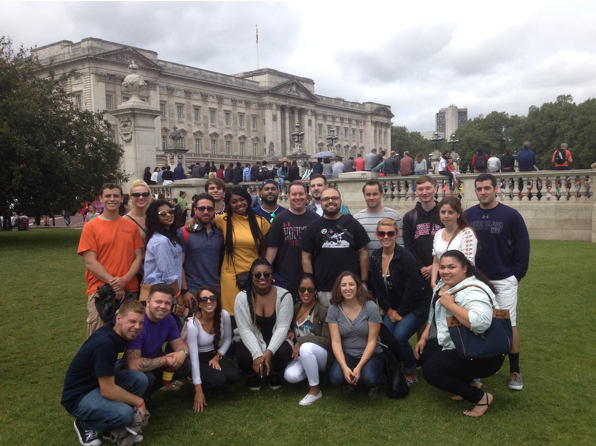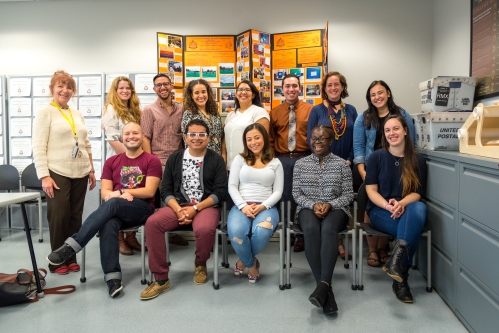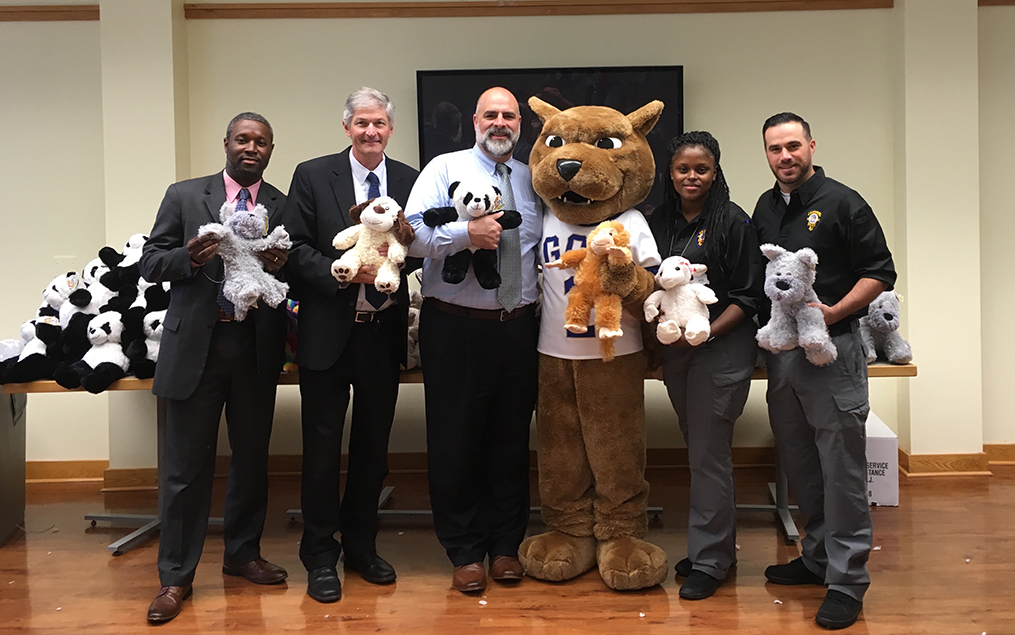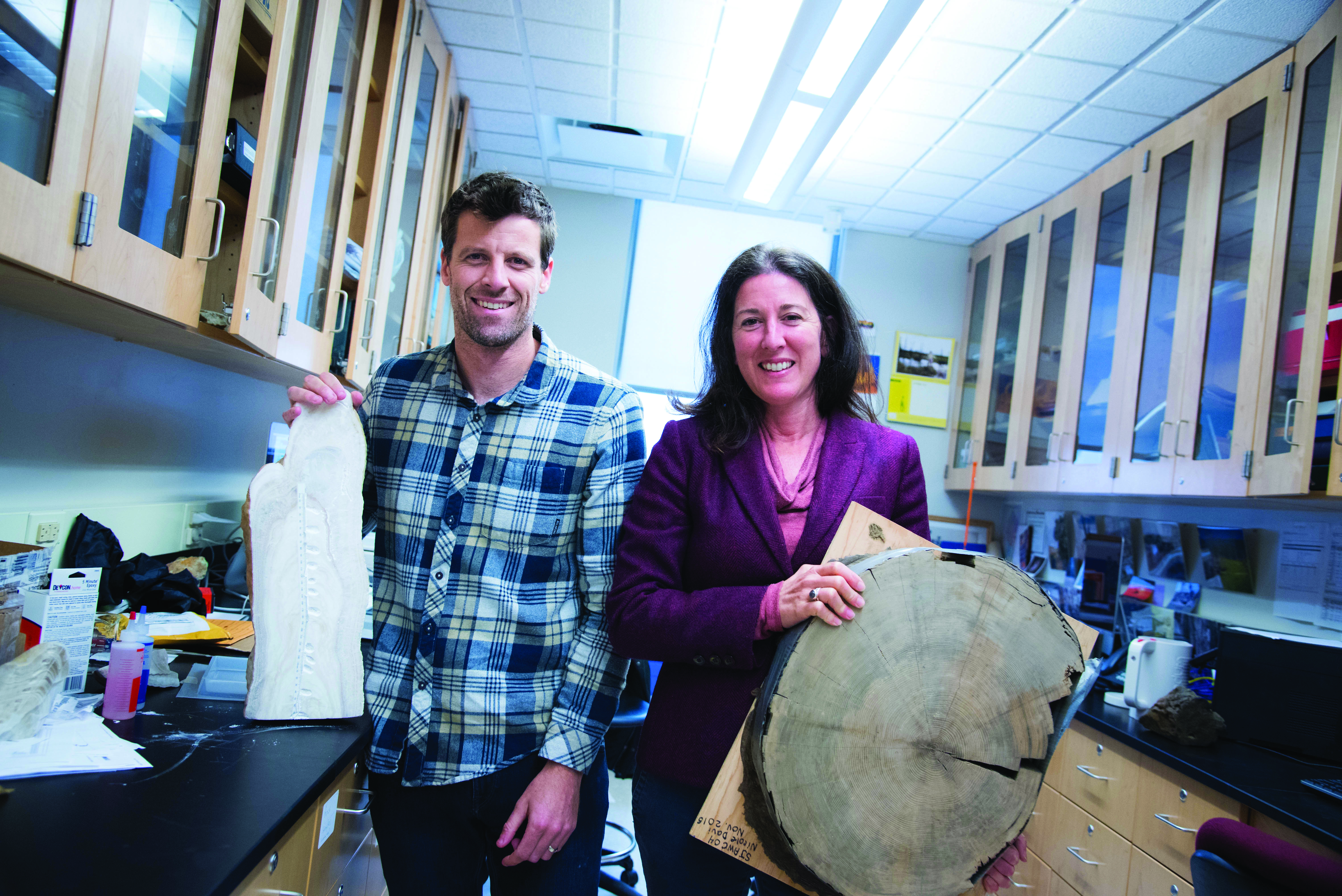
Ryan J. Rebe, PhD, William Paterson University assistant professor of political science with 2016 William Paterson students at Buckingham Palace
Seventeen William Paterson University students will spend three weeks during July and August 2017 studying comparative and international political issues at St. Edmund’s College, part of Cambridge University in England, through the University’s Summer Program at Cambridge.
Now in its 18th year, the program provides students with the opportunity to study alongside students from more than 75 nations at one of the world’s top educational institutions. The program is directed by Michael Principe, professor of political science and a visiting fellow at St. Edmund’s College for 25 years; to date, more than 225 students have participated in the program.
The students—11 undergraduate and 6 graduate students—will take two classes: Comparative Rights, taught by Principe, and Comparative Social Policy, taught by Maya Chadda, a William Paterson University professor of political science and an expert in international relations and comparative policy. Participants spend a week preparing for the trip and three weeks at Cambridge.
“The program is designed to provide students with an intellectually and personally rewarding experience in one of the world’s most respected academic institutions. By exposing them to different ways of thinking and developing their awareness of critical issues in a foreign setting, students broaden their horizons and develop essential intellectual skills that can greatly benefit them in their careers,” says Principe.
During the program, students get the opportunity to sit in daily lectures in St. Edmund’s College do research in both the Squire Law Library and Cambridge University Library, visit London and Houses of Parliament, and take advantage of a number of social, educational, and research opportunities in the university, including living among and interacting with graduate students representing more than 75 nations that reside in St. Edmund’s College.
“The students come back home with an entirely different view of global affairs,” Principe adds. “Their views shift dramatically, and they seem more mature—they comprehend more because they develop critical thinking skills that help them to understand the world around them.”
The trip solidified a major life choice for Chris Bauer, a 2013 graduate of William Paterson with majors in legal studies and political science. “I was going to work as a paralegal for a couple of years after graduation, but my time in Cambridge made me realize what I could do,” he says. With Principe’s encouragement, he applied and was accepted to West Virginia Law School, from which he graduated in 2016 and was named executive editor of the Law Review. He is currently an associate with the international law firm Steptoe & Johnson and will be clerking for the Honorable Robert W. Trumble of the United States District Court for the Northern District of West Virginia from 2017–2018.
William Paterson’s Summer in Cambridge Program is just one of several unique international study options that are specific to the University. Programs include Summer Art in China, a biannual trip which provides an intensive, three-week cultural immersion in the art and history of China, as well as regular study tours to Italy, the Netherlands, and Japan.
William Paterson University Students Participate in NASA Project to Make STEM (Science, Technology, Engineering and Math) More Interesting for all K-20 Students
–William Paterson is now a member of the NASA MSI (Minority Serving Institution) Emerging Stars Network
Six William Paterson students participated in the 2017 Minority University Research and Education Project (MUREP) Educator Institute held from June 12 to 16, 2017 at the NASA Goddard Space Flight Center in Greenbelt, Maryland. The students, all STEM and education double majors, included: Nataly Gaspar, Noelle Mironis, Summer Pirro, Andrew Santiago, Stephanie Tapia-Nunez, and Katherine Zimny. Jyoti Champanerkar, associate professor of mathematics, served as faculty sponsor.

Jyoti Champanerkar, PhD, William Paterson University associate professor of math (third from left), with William Paterson students [L to R] Andrew Santiago, Nataly Gaspar, Katherine Zimny, Noelle Mironis, Stephanie Tapia-Nunez, Summer Pirro at the 2017 Minority University Research and Education Project (MUREP) Educator Institute
Prior to the trip, the students watched a series of STEM-based webinars and will complete additional web-based professional development in July. The purpose of the NASA experience is to help the future teachers develop K-20 instructional practices that will make STEM more relevant and interesting for all students.
As a result of this participation, William Paterson University is now a member institution of the NASA MSI (Minority Serving Institution) Emerging Stars Network. The NASA MSI Emerging Stars Network is a partnership between the NASA Educator Professional Development Collaborative (EPDC) and Minority Serving Institutions (MSI) to enrich STEM teacher preparation through NASA professional development opportunities and educational resources. https://www.txstate-epdc.net/nasa-msi-emerging-stars-network/
U.S. Department of Education Awards Fulbright-Hays Grant to William Paterson Professors for Group Study in Israel
–College of Education faculty professors Sandra Alon and Laura Fattal, along with six aspiring teachers and six professional teachers, on month-long trip by means of Fulbright-Hays grant
Six William Paterson University students pursuing careers as teachers and six active New Jersey teachers are traveling to Israel from July 3 to August 1, 2017 through a Fulbright-Hays grant from the U.S. Department of Education. Sandy Alon and Laura Fattal, professors in William Paterson’s College of Education, were co-awarded $95,000 to lead the four-week group trip. The Fulbright-Hays Group Projects Abroad grant seeks to advance K-12 teachers’ cultural awareness of and interdisciplinary instruction about Israel.
While in Israel, the group of selected applicants will take part in experiential learning that includes visits to UNESCO historical sites, unique environmental landscapes and museums, as well as lectures at prominent educational institutions and hands-on learning with innovators of education technology.
Prior to the trip, participants learned the basics of Modern Hebrew and emergent bilingual teaching strategies. Following the trip, they will develop a handbook of interdisciplinary lessons and an online photo-essay that documents their experience— an exercise in teaching global studies by means of the visual arts.

Sandra Alon, EdD, William Paterson University associate professor of education, with William Paterson University students pursuing careers as teachers and active New Jersey teachers who are traveling to Israel through a Fulbright-Hays grant from the U.S. Department of Education
“With our University’s location in northern New Jersey—a multicultural area—it is paramount that we develop teachers who are culturally competent and equipped to provide inclusive instruction that advances global education,” said College of Education Dean Candace Burns.
Alon, an associate professor of educational leadership and curricula studies, serves as director of the College’s Center for Mathematics Success program. There, she trains teachers in methods of intervention for at-risk mathematics students from communities surrounding William Paterson’s campus. The studies provided under this grant, she said, will allow her to better prepare those teachers to meet the needs of diverse student populations.
Fattal, an associate professor focusing on arts integration courses for aspiring teachers, has served as the co-chair of the College’s Diversity and Curriculum Committee and is currently performing research on bilingualism and the arts. She is part of the Fulbright Specialist scholar roster, whereby she is asked to apply for education consultant positions around the world.
The Fulbright-Hays Group Projects Abroad program assists U.S. institutions of higher education, state departments of education and private nonprofit educational organizations with the promotion, improvement and development of area studies and modern foreign language. The funds support short-term overseas projects that focus on training, research and curriculum development in those disciplines.
William Paterson has a history of global educational exchanges. The University has taken part in student and/or teacher cross-cultural programming in the Netherlands, India, Namibia and South Korea. Research on communicative strategies used by teachers of non-native language learners is ongoing between William Paterson and the Western Galilee College in Israel by means of publications and conference presentations. Implementation of technology has been pivotal in their shared goals of creating intercultural dialogue and innovative lessons while advancing inquiry-based global teaching and learning.
“This award provides extraordinary opportunities for teacher candidates, teachers, and faculty to further their global education and deepen understanding through intensive engagement supported by this grant,” Burns says.
William Paterson University Environmental Science Professor Martin Becker Featured in New Documentary, The Underground Forest
–Film details the discovery and exploration of an ancient cypress forest 60 feet underwater in the Gulf of Mexico
Martin Becker, a paleontologist and professor of environmental science at William Paterson University, is one of three scientists featured in a new documentary, The Underwater Forest, that details the discovery and exploration of an ancient cypress forest found in 60 feet of water in the Gulf of Mexico, 10 miles due south of Gulf Shores, Alabama.
Co-produced by This is Alabama and the Alabama Coastal Foundation, the documentary was written, directed and filmed by journalist Ben Raines.

Martin Becker, PhD, William Paterson University environmental science professor, is featured in a new documentary, The Undergraduate Forest. Professor Becker’s research is focused on fossil shark teeth.
Becker’s principal research is focused on fossil shark teeth found in locations hundreds of miles from the shoreline. He has traveled across the United States to inland areas from Arkansas and South Dakota to Utah and Alabama to collect fossils, which allow researchers to develop climate timelines from millions of years ago and track changes in sea levels. In the film, he is shown collecting shark teeth at an inland Alabama site more than 100 miles from the shoreline, where he finds dozens of 35-million-year-old shark teeth, as well as diving to the site.
“More than half the state of Alabama at one time was submerged underneath an ancestral ocean that dates back to the time of the dinosaurs,” Becker says in the film. “The record of that is recorded in the fossils, and in the regional geology…the Underwater Forest is about 120 miles distant, and the water in that area is about 60 feet deep. So, you are talking about a substantial amount of sea level change.”
The forest dates to an ice age more than 60,000 years ago, when sea levels were about 400 feet lower than they are today. The only known site where a coastal ice age forest this old has been preserved in place, with thousands of trees still rooted in the dirt they were growing in millennia ago, the location is providing new insights into everything from climate in the region to annual rainfall, insect populations, and the types of plants that inhabited the Gulf Coast before humans arrived in the new world. Scientific analysis of the site is ongoing.
Categories: Public 4-Year Schools

 As 2017 draws to a close, it is time for us to reflect on the progress we have made and the challenges ahead of us. A few weeks ago, my office hosted an event entitled, “65 by ’25… Many Paths, One Future: The Equity Imperative,” at the Educational Testing Service (ETS) in Princeton. We heard an enlightening address from Dr. Michael T. Nettles, ETS senior vice president for research, and recognized four New Jersey programs for excellence and equity in education.
As 2017 draws to a close, it is time for us to reflect on the progress we have made and the challenges ahead of us. A few weeks ago, my office hosted an event entitled, “65 by ’25… Many Paths, One Future: The Equity Imperative,” at the Educational Testing Service (ETS) in Princeton. We heard an enlightening address from Dr. Michael T. Nettles, ETS senior vice president for research, and recognized four New Jersey programs for excellence and equity in education.





